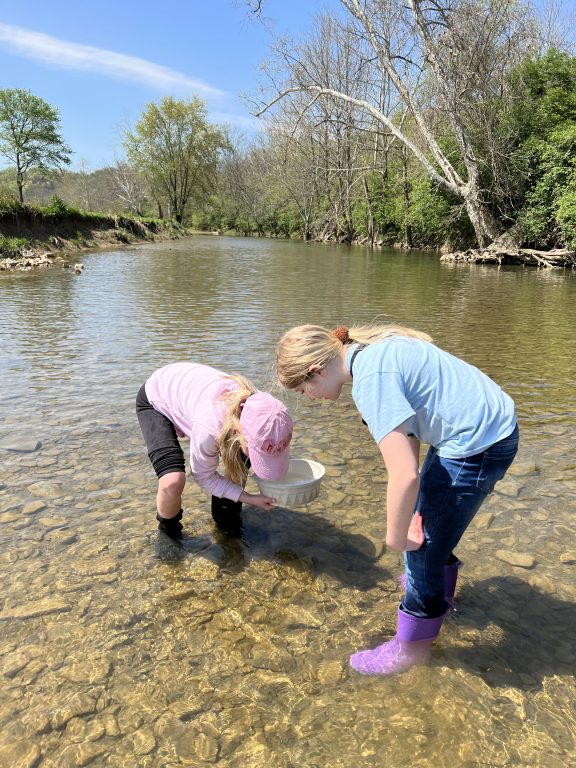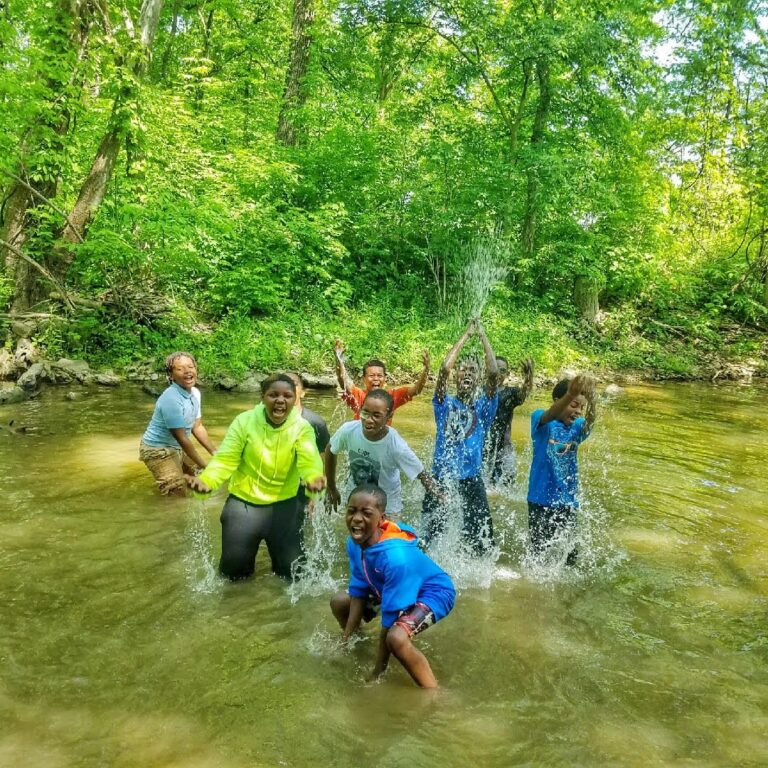Chances are you have memories of playing in a creek as a kid. Even if this wasn’t part of your regular routine, if you did it, even once, the experience has stuck with you. You can probably recall the feeling you had freely playing, exploring, and splashing in the wild watery world.
Memories like these stick with you because they are hugely impactful to children. Nature-based play, like creeking, engages the whole child in learning–physically, mentally, spiritually, socially, and academically. Research has shown time and time again that being in nature can increase creativity and focus, boost happiness, reduce attention fatigue and stress, relieve anxiety, and enhance connection.
Specifically for children, balancing and finding your way through shallow water over slippery rocks is the ultimate exercise in developing gross motor skills. Giving children the chance to test gross motor skills on varied natural surfaces unlike the flat, consistent, predictable surfaces found indoors and on many playgrounds is critical to their development and growth. The same is true for fine motor skills that utilize small muscle movements in hand and finger coordination. What better way to practice these skills than turning over rocks in the water and picking up snails and other small macroinvertebrates? Or building stick boats and following them down the stream? The opportunities for fun and development are endless.
A Free Pass to Exploration
Living in the Ohio River Watershed means we have access to so many creeks and streams ready to serve up amazing and memorable creeking experiences for children of all ages. This outdoor activity is FREE and available to anyone willing to get out there. No expensive clothing or equipment is required, just a willingness to get a little wet and muddy. Kids just need an adult willing to let them explore! You can be that adult for a child in your life and we want to make it easy and comfortable for you.
Since 2005 the Ohio River Foundation has hosted over 50,000 kids in local waterways as part of our River Explorer program. During River Explorer kids wade into the water and using real science equipment and techniques determine the health of the waterway. They also splash, play, and have a lot of fun. We have A LOT of experience letting kids learn through creeking and we want to see you out there making your own memorable experiences with your kids. Here’s how to do it in an easy, safe, and fun way:
Step One: Pick your location.
Choose your ideal location for your creeking adventure. There are so many places to check out locally! Check out our list of favorite places, complete with hints on how to easily find the water once you’re in the park and locations that have handy amenities (bathrooms, nearby parking lot, moderate banks for easy access for young and old, etc.)
Step Two: Check the weather and be aware of the water level and recent rainfall
You’re obviously not going to head out in frigid temperatures or take kids out during heavy rain or a storm, but it’s smart to take into consideration recent rainfall. If there has been recent heavy rain, chances are the stream or creek might be running too fast to safely play.
Before you get in the water always observe safely from the banks for a few minutes. If you see dry rock cobble or sand beaches and the water is flowing at a slow gentle rate, it is probably safe to get in. But always have an adult check first by wading in and determining if the flow is safe for children based on their age and ability.
If you notice the water is flowing quickly, there isn’t much of a rocky or sandy beach because the water is right up to the bank, the water is muddy and turbulent, you see branches, logs, or even trees floating by, the water is running in a straight fast pattern DO NOT ENTER the water or get close. These are signs that the water could be very dangerous and water levels could still be rising.
Recent rainfall can also help you predict if it is healthy enough to enter because of runoff. Unfortunately, chemical pollution, harmful algae, and bacteria levels are all things we need to consider before entering the water. Because of the hard work of federal, state, and local governmental and nongovernmental organizations like Ohio River Foundation, it’s usually safe to play in many of our local creeks and rivers. BUT you have to pay attention and stay informed. After a heavy rainfall, it’s a good rule of thumb to stay out of local waterways for approximately 72 hours. Always wash your hands after being in the water and of course, make sure not to ingest any water.
Sometimes water levels can be a little high even on days we haven’t had any rain because of upstream dam releases. If you want to be super prepared you can check apps like Rivercast (https://www.rivercastapp.com/) for water levels in real-time. Insider tip: a water level over 6 feet on the Little Miami River at the gauge measuring in Milford, Ohio typically means the water is too high and running too fast for us to safely take kids into the water.
Step Three: Have fun!
The best thing you can do as an adult to facilitate a creeking experience is to let your kids follow their interests and instincts. Your role can simply be to set the basic rules and boundaries to keep everyone safe and model and encourage by being curious and adventurous yourself. For kids who are new to creeking it might be really important for them to see you happily and confidently splash out to the middle of the creek and poke around. What you will probably find, as we often do in our programs, is that the most hesitant and nervous kids just need a few minutes watching someone else enjoy the water to decide they want to get in and forget about all their fears and anxieties.
For kids who might be more familiar with nature play and outdoor activities your biggest job is–not to get too involved! Let them explore, discover, and follow their curiosities. Sometimes too much adult involvement can interrupt the magical experience and confidence building that can be gained from independent outdoor play for a child.
Give yourself the chance to step back and observe the fun or get lost exploring yourself. You won’t believe the creatures you can find turning over rocks in a shallow stream. The most powerful influence for children is modeling the behavior you want to see, so if you’re having fun they will too!


